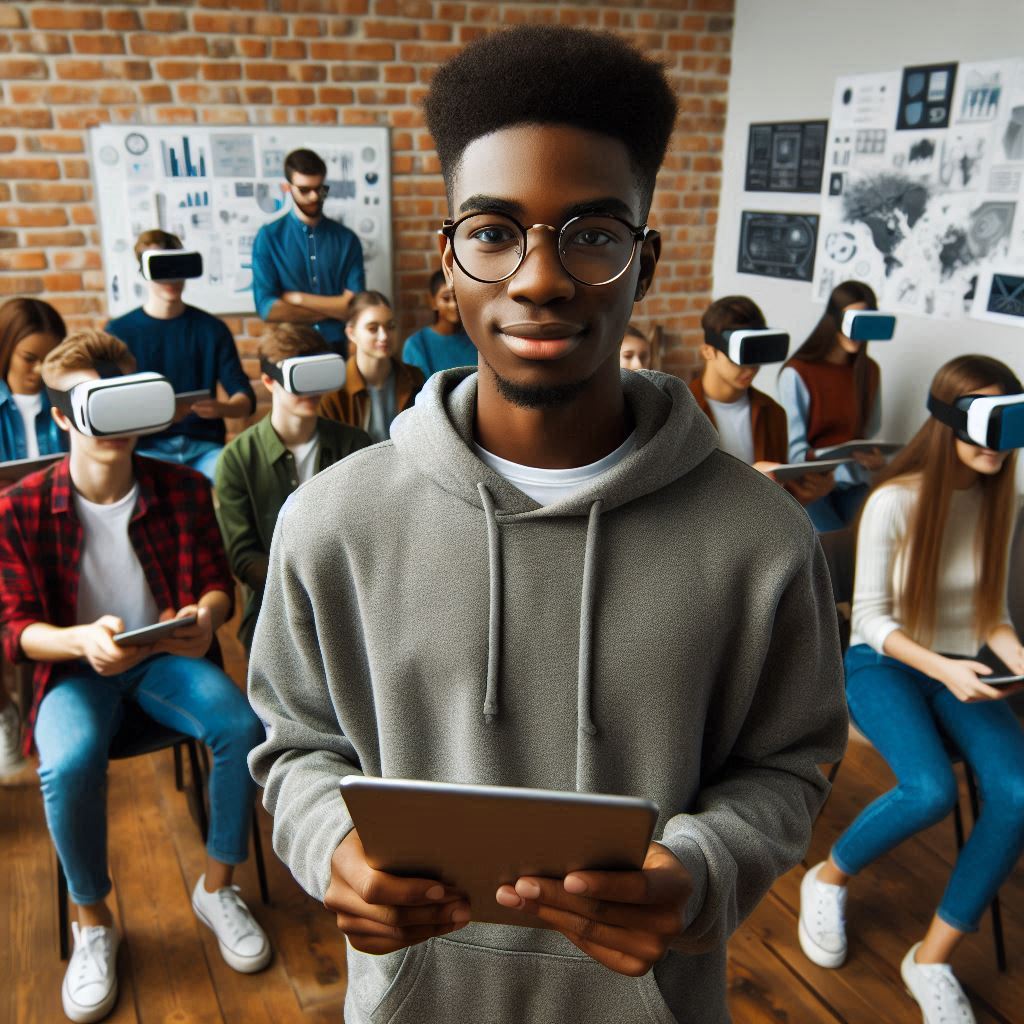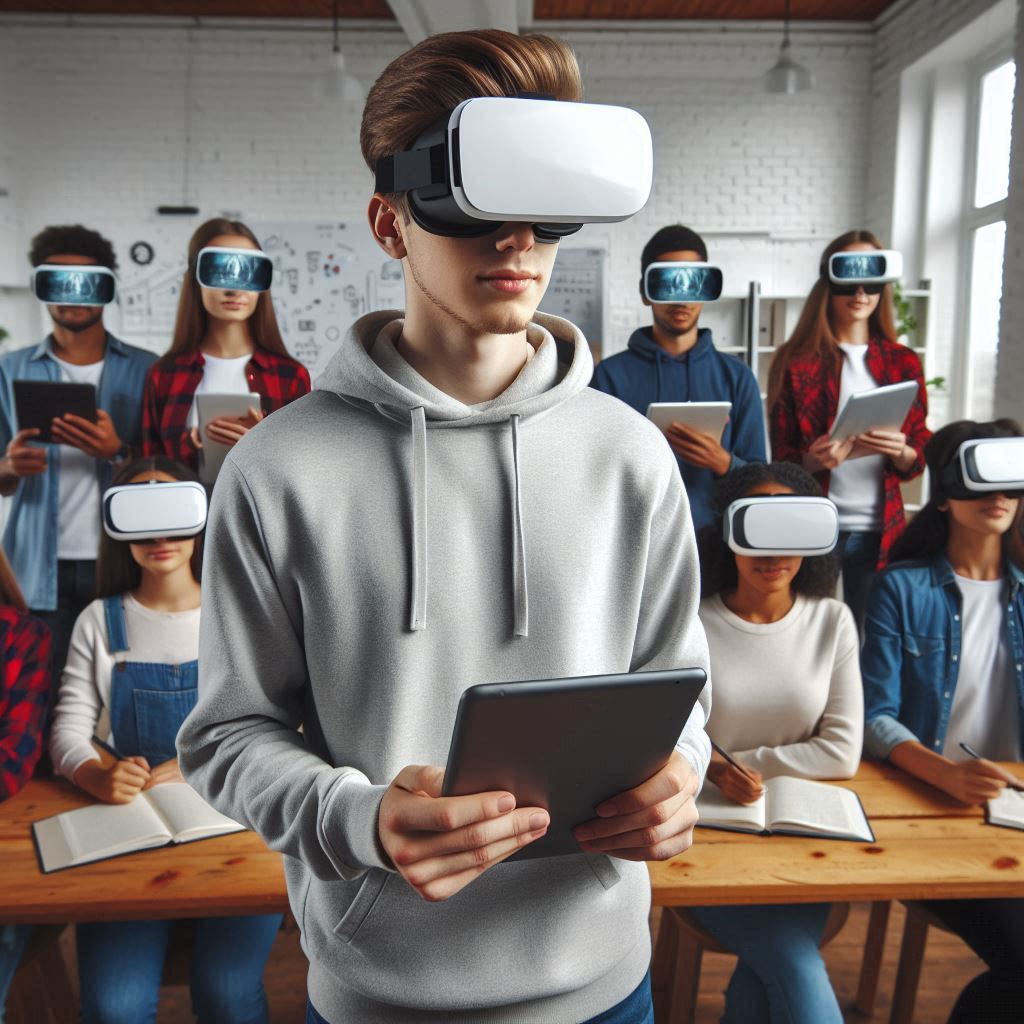Introduction
Let’s explore augmented reality software for immersive science education in classrooms
Definition of Augmented Reality (AR)
Augmented Reality (AR) overlays digital information onto the physical world.
This technology enhances user perceptions by blending real and virtual elements.
Users can interact with both environments simultaneously through devices like smartphones or AR glasses.
Overview of the Role of AR in Education
AR significantly transforms educational experiences.
It creates engaging and interactive learning environments.
Students can visualize complex concepts through interactive 3D models and simulations.
Teachers can provide personalized instruction, adapting to varied learning styles.
This technology encourages exploration and inquiry-based learning, making lessons more captivating.
Importance of Immersive Learning Experiences in Science Education
Immersive learning experiences enhance student understanding and retention.
In science education, engaging students actively fosters curiosity and critical thinking.
Students can manipulate and observe phenomena that are typically invisible, such as atomic structures or chemical reactions.
These experiences deepen understanding and make abstract concepts tangible.
Additionally, immersive experiences promote collaboration among students, encouraging teamwork in problem-solving activities.
Purpose of the Blog Post: To Explore AR Software for Enhancing Science Education
This blog post aims to examine various AR software applications designed for science education.
We will highlight how these tools enrich the learning process and stimulate student interest.
By showcasing innovative AR solutions, we illustrate the potential of technology in fostering scientific literacy.
Our exploration will include case studies demonstrating improved engagement through AR.
Ultimately, we aim to inspire educators to integrate AR into their curricula for enhanced learning outcomes.
The Mechanics of Augmented Reality
Explanation of how AR technology works
Augmented Reality (AR) technology enhances the real-world environment through digital overlays.
These overlays provide interactive experiences that captivate learners in immersive science education.
Key components make AR technology effective and engaging for classroom use.
Image recognition
Image recognition forms the backbone of many AR applications.
This technology identifies and processes physical objects and images in real time.
AR software uses cameras and sensors to capture the real world.
It then analyzes images and detects features that serve as triggers for digital overlays.
When a user points their device at a specific object, the software recognizes it.
Upon recognition, it displays relevant digital content, making information accessible and interactive.
This process allows students to interact with 3D models and animations.
Consequently, AR fosters a deeper understanding and retention of scientific concepts.
3D modeling and rendering
3D modeling and rendering are essential aspects of AR technology.
They create realistic digital objects that blend seamlessly into the real world.
Developers design these 3D models using specialized software.
They ensure models are scientifically accurate and visually appealing.
Once completed, these models require rendering for effective display.
Put Your Tech Company on the Map!
Get featured on Nicholas Idoko’s Blog for just $50. Showcase your business, boost credibility, and reach a growing audience eager for tech solutions.
Publish NowRendering involves generating images from 3D models using computer graphics.
High-quality rendering produces smooth animations and realistic appearances.
This level of detail captures students’ attention during science lessons.
Combining image recognition with 3D models creates an engaging learning environment.
For instance, students can observe a 3D model of a human heart while discussing its functions.
This interactive approach promotes deeper learning and understanding of complex concepts.
Types of devices used for AR experiences
Various devices facilitate AR experiences in the classroom.
These devices differ in functionality, ease of use, and access to AR content.
Educators can utilize the following types of devices:
Smartphones and tablets
Smartphones and tablets are the most accessible entry points for AR experiences.
Most students own or have access to these devices, making them ideal for classroom integration.
AR apps available on platforms like iOS and Android provide a wealth of interactive content.
Using smartphones and tablets in classrooms allows learners to engage with AR content seamlessly.
They can scan educational materials or participate in AR-enabled activities.
This integration enhances student interaction and collaboration.
AR glasses and headsets
AR glasses and headsets represent a more advanced option for immersive learning experiences.
These devices offer hands-free interaction and deep immersion in AR content.
While more expensive, they provide rich, engaging experiences that can enrich science education.
Some notable AR headsets include Microsoft HoloLens and Magic Leap One.
These devices overlay digital elements onto the real world, providing users with 360-degree views.
Students can explore complex scientific phenomena in innovative ways using these advanced tools.
The difference between AR, VR (Virtual Reality), and MR (Mixed Reality)
Understanding the distinctions between AR, VR, and MR is vital for effective curriculum development.
Each technology offers different functionalities and learning experiences.
Augmented Reality (AR)
- Enhances the real world with digital content.
- Utilizes devices like smartphones, tablets, and AR glasses.
- Allows interaction with real-world environments while displaying digital overlays.
Virtual Reality (VR)
- Creates entirely immersive digital environments.
- Requires specialized headsets, such as Oculus Rift or HTC Vive.
- Users cannot see the real world while using VR systems.
Mixed Reality (MR)
- Combines elements of both AR and VR.
- Allows users to interact with both real and virtual elements simultaneously.
- Utilizes advanced devices like Microsoft HoloLens for greater interaction.
In summary, AR enhances reality with digital information, VR creates fully immersive environments, and MR merges both aspects for a versatile experience.
Choosing the right technology depends on the specific educational objectives and resources available.
Augmented Reality technology plays a critical role in immersive science education.
By understanding the mechanics behind AR, educators can better implement these tools.
They can enhance their students’ learning and engage them in ways traditional methods cannot.
This adoption makes science education more relevant, exciting, and impactful.
Read: Virtual Reality Classrooms: The Future of Interactive Distance Learning
Benefits of Augmented Reality in Science Education
Enhanced Engagement and Motivation Among Students
Augmented Reality (AR) dramatically increases student engagement.
It transforms dull lessons into immersive experiences.
Students become active participants in their learning journey.
They explore new worlds, concepts, and experiments through AR.
This interactivity sparks curiosity. It makes science education exciting and relatable.
Put Your Tech Company on the Map!
Get featured on Nicholas Idoko’s Blog for just $50. Showcase your business, boost credibility, and reach a growing audience eager for tech solutions.
Publish NowFor instance, students can visualize the human body.
They explore organs in 3D, gaining a better understanding.
Such experiences inspire them to learn more.
This deeper level of engagement boosts motivation.
When students are engaged, they are eager to learn.
Teachers see a noticeable increase in participation and enthusiasm.
In many classrooms, AR tools foster collaboration.
Students work together, discussing their findings.
This peer interaction encourages a supportive learning environment.
As students share their discoveries, they motivate each other.
Schools report higher attendance rates when AR is implemented.
Students no longer view science as a subject but as an adventure.
Improved Understanding of Complex Scientific Concepts
AR provides unique visualizations of complex concepts.
It allows students to interact with theoretical models.
They can manipulate molecules, observe chemical reactions, and explore ecosystems.
These experiences create lasting mental images.
Students learn better when they can see and manipulate concepts.
Traditional textbooks cannot convey 3D structures effectively.
Students often find it hard to visualize abstract ideas.
AR overcomes this challenge by bringing concepts to life.
For example, learning about the solar system becomes an out-of-this-world experience.
Students witness planetary movements and gravitational effects in real-time.
This visual comprehension leads to deeper understanding.
Students grasp intricate details they might otherwise miss.
AR can break down challenging topics into digestible parts.
For example, dissecting a digital frog is easier than handling a real one.
This method fosters confidence in students, enhancing their desire to experiment further.
Opportunities for Hands-On Learning Without Limitations of Physical Materials
AR creates limitless opportunities for hands-on learning.
It transcends the restrictions that come with physical materials.
Classrooms often face limitations in available resources and equipment.
With AR, students can conduct experiments digitally.
They explore scientific principles without the fear of mistakes.
For example, in chemistry, students can mix virtual substances.
They observe reactions without any hazardous risks.
This approach alleviates concerns over safety and waste.
Put Your Tech Company on the Map!
Get featured on Nicholas Idoko’s Blog for just $50. Showcase your business, boost credibility, and reach a growing audience eager for tech solutions.
Publish NowSchools can also revisit expensive experiments without financial burdens.
This flexibility allows students to engage in trial-and-error learning.
Another benefit is the accessibility of rare specimens.
Students can study fossils, rare minerals, or microscopic organisms.
With AR, they can explore these resources from anywhere.
This accessibility ensures that all students can experience science education equally.
No student is left behind due to resource limitations.
Adaptability for Diverse Learning Styles and Needs
AR accommodates various learning styles and needs.
Each student learns differently, and AR provides tailored experiences.
Visual learners benefit from 3D models and simulations.
Kinesthetic learners can manipulate virtual objects.
Auditory learners can listen to guided explanations during activities.
Teachers can customize AR experiences.
They can adapt lessons to fit group dynamics and individual learning preferences.
This adaptability enhances the learning process significantly.
It addresses specific needs, promoting inclusivity in classrooms.
Students with disabilities can also benefit from AR.
Interactive elements help capture their attention.
Visual and auditory enhancements assist with comprehension.
Students feel empowered when they engage with materials effectively.
AR breaks down barriers, fostering a sense of belonging.
Other Notable Benefits of Augmented Reality in Science Education
- Real-time feedback enhances learning. Students receive instant results on quizzes and activities.
- AR fosters critical thinking skills. Students analyze results and draw conclusions based on observations.
- It encourages interdisciplinary learning. Students integrate science with art, technology, and engineering.
- AR can be applied in remote learning. Students can explore AR content from the comfort of their homes.
- It prepares students for the digital world. They become familiar with technology used in modern careers.
The rapid advancement of AR technology revolutionizes science education.
It enhances engagement, understanding, and adaptability in classrooms.
Students experience an enriched learning environment.
They can interact with complex concepts in meaningful ways.
This immersive technology prepares them for future challenges.
Overall, AR transforms science education into an exciting and effective learning experience.
Read: AI-Based Curriculum Design Software for Personalized Learning Paths
Examples of Augmented Reality Software for Classrooms
Overview of popular AR applications used in science education
Augmented Reality (AR) applications have transformed how educators teach science.
These innovative tools engage students in active learning.
Here are some popular AR applications that educators frequently use:
Google Expeditions
Google Expeditions enables teachers to take students on virtual field trips around the world.
The platform offers over 900 immersive experiences, including 360-degree videos and AR experiences.
Educators can guide students through different environments, from the surface of Mars to the depths of the ocean.
This application enhances understanding of complex scientific concepts by providing visual context.
Put Your Tech Company on the Map!
Get featured on Nicholas Idoko’s Blog for just $50. Showcase your business, boost credibility, and reach a growing audience eager for tech solutions.
Publish NowStudents appreciate the hands-on approach as they explore locations they would otherwise never visit.
Merge Cube
Merge Cube is an interactive learning tool that takes advantage of AR technology.
Students can hold a physical cube that displays 3D holograms when viewed through a compatible device.
This allows for interactive lessons on biology, physics, and more.
For instance, students can explore the human body, dissecting organs through the cube without any physical mess.
Teachers find that this tool sparks curiosity and encourages exploration, making difficult subjects more approachable.
Zspace
Zspace combines AR and Virtual Reality (VR) to create an immersive learning environment.
Students wear special glasses that enable them to interact with 3D holograms in real-time.
This platform allows for dynamic lessons in biology, engineering, and physics.
For example, students can manipulate molecules or construct complex systems while learning key concepts.
Zspace makes science tangible and exciting, promoting student engagement through hands-on learning.
Quiver
Quiver uses coloring books as a gateway to the AR experience.
Students color in images and use a compatible device to bring their creations to life.
The app layer overlays animations on the colored pages, creating an engaging experience.
This unique blend of art and science encourages creativity alongside education.
Teachers benefit by integrating fun into science lessons, capturing students’ interest more effectively.
Case studies or testimonials from teachers about specific applications
Numerous educators have embraced AR applications in their classrooms.
Here are a few testimonials highlighting their impact:
- Google Expeditions: A biology teacher, Ms. Johnson, implemented Expeditions during her cell biology unit. She stated, “The students were mesmerized by taking a virtual tour of a cell. They could see organelles in 3D rather than just in a textbook. It brought clarity and excitement to the subject.”
- Merge Cube: Mr. Smith, a high school chemistry teacher, shared his experience using Merge Cube. “My students found chemistry concepts much easier when they could visualize atomic structures. The hands-on interaction made them more eager to learn,” he explained.
- Zspace: A physics instructor, Ms. Chen, described her class experience. “Zspace has changed how I teach mechanics. Students interactively explore forces and motion. Lessons feel less like lectures and more like explorations,” she highlighted.
- Quiver: Art teacher Ms. Lopez integrated Quiver into her science curriculum. “Combining art with science was revolutionary for my students. It allowed them to express creativity while learning about ecosystems. The engagement levels soared,” she shared.
Brief analysis of the strengths and weaknesses of each platform
While these AR applications offer exciting opportunities, they each have their strengths and weaknesses.
Here’s a closer look:
Google Expeditions
- Strengths: Extensive library of experiences and user-friendly interface.
- Weaknesses: Requires internet access, which may limit use in some areas.
Merge Cube
- Strengths: Engaging and interactive, providing a tactile learning experience.
- Weaknesses: Dependence on mobile devices, which may create accessibility concerns.
Zspace
- Strengths: Immersive experience enhances understanding of complex concepts.
- Weaknesses: High cost and technical requirements may deter some schools.
Quiver
- Strengths: Simple setup and appeals to students’ creative sides.
- Weaknesses: Limited depth in scientific content compared to other applications.
In fact, AR applications offer transformative learning experiences in science education.
Each platform has unique features that can cater to distinct educational needs.
By leveraging these technological advancements, teachers can create engaging and immersive science lessons.
As educators continue to explore these innovations, they will likely discover new ways to transcend traditional teaching methods.
The future of science education lies in the hands of innovative educators willing to embrace technology.
Read: How Open-Source LMS is Revolutionizing University Education in 2024 & 2025

Integrating AR into the Science Curriculum
Steps for teachers to incorporate AR into lessons
Integrating Augmented Reality (AR) into science education enhances student engagement and understanding.
Teachers can follow a structured approach to create an immersive learning environment.
Planning and preparation
Planning is crucial for effective integration of AR in the classroom.
Teachers should consider the following points:
- Curriculum alignment: Ensure AR resources align with specific learning objectives.
- Resource identification: Research and select quality AR applications suited for the lesson.
- Learning outcomes: Define what students should achieve from the AR experience.
- Time management: Allocate sufficient time for activities, ensuring a balance between traditional and AR methods.
Technology setup and accessibility
A seamless technological setup is vital for successful AR integration.
Consider these aspects:
- Device availability: Ensure all students have access to compatible devices, such as tablets or smartphones.
- Application installation: Verify that necessary AR applications are installed before the lesson begins.
- Connectivity: Ensure a reliable internet connection to support AR applications.
- Technical support: Prepare for potential technical issues by having support staff available.
Suggestions for classroom activities using AR
Leveraging AR in classroom activities can make science concepts more tangible for students.
Below are some innovative ideas:
Virtual dissections
Virtual dissections using AR allow students to explore anatomy without the ethical concerns of real dissections.
Put Your Tech Company on the Map!
Get featured on Nicholas Idoko’s Blog for just $50. Showcase your business, boost credibility, and reach a growing audience eager for tech solutions.
Publish NowKey elements include:
- Realistic visualizations: Use AR to provide 3D models of organisms.
- Step-by-step tutorials: Provide students with guided instructions for exploration.
- Interactive features: Allow students to manipulate organs and tissues virtually.
- Assessment opportunities: Incorporate quizzes assessing knowledge after the dissection.
Interactive simulations of chemical reactions
AR can help students visualize complex chemical processes during lessons.
Here’s how:
- Reaction visualization: Allow students to see chemical reactions in real-time through AR apps.
- Element manipulation: Let students change elements or conditions to observe results.
- Contextual learning: Provide historical context or real-world applications of reactions.
- Collaboration: Encourage group activities where students discuss and analyze results together.
Addressing potential challenges and resistance from educators
Integrating AR technology may encounter resistance from some educators.
It is essential to address potential challenges proactively:
- Professional development: Offer workshops to familiarize educators with AR tools and methods.
- Peer support: Encourage collaboration among teachers to share experiences and insights.
- Demonstrating effectiveness: Provide evidence showcasing how AR enhances learning outcomes.
- Budget constraints: Explore grant opportunities or partnerships for funding AR resources.
- Student feedback: Collect and analyze student responses to AR activities to improve future lessons.
By providing support, resources, and a clear focus on student engagement, teachers can effectively overcome resistance.
As educators innovate their teaching methods, they can significantly enrich the educational experience.
In essence, integrating Augmented Reality into the science curriculum offers numerous benefits to students.
The successful adoption of AR in classrooms promotes immersive learning and enhances critical thinking.
As we embrace new technologies, educators must stay informed and adapt their teaching strategies.
The future of science education lies in leveraging tools that make learning both exciting and impactful.
Read: Software Solutions for Adaptive Learning in Special Education Programs
Assessing the Impact of AR in Learning Outcomes
Research Findings on the Effectiveness of AR in Science Education
Augmented Reality (AR) has transformed how educators approach science instruction.
Numerous studies highlight AR’s effectiveness in enhancing student learning outcomes.
Researchers find that AR actively engages students and stimulates their motivation.
Here are key findings supporting this claim:
- Enhanced Comprehension: AR allows students to visualize complex concepts. This visualization helps clarify abstract topics, such as molecular structures.
- Increased Retention: Students exposed to AR content demonstrate better retention of information. The immersive nature of AR promotes deeper cognitive processing.
- Improved Collaboration: AR fosters a collaborative learning environment. Students tend to work together to explore and solve problems, enhancing teamwork skills.
- Higher Engagement Levels: Many students report heightened interest when using AR. The interactive elements of AR capture attention more effectively than traditional methods.
- Real-life Applications: AR connects theoretical concepts to real-world applications. This relevance aids in bridging the gap between knowledge and practical use.
Tools and Methods for Evaluating Student Performance and Engagement
To measure the impact of AR on student learning, educators use various tools and methods.
These evaluations provide insights into both student performance and engagement levels.
Here are some effective strategies:
- Surveys and Questionnaires: Educators can design surveys to gauge student satisfaction. Questions can assess their perception of AR impact on their learning.
- Classroom Observations: Teachers can observe student interactions during AR activities. This can indicate levels of engagement and collaboration.
- Performance Assessments: Tests and quizzes can be administered after AR sessions. Comparing results to traditional methods indicates effectiveness.
- Focus Groups: Conducting focus groups helps gather qualitative data. Students can share experiences and insights about using AR.
- Analytics from AR Software: Many AR tools have built-in analytics. Educators can track student progress and identify areas needing improvement.
Comparative Analysis Between Traditional Teaching and AR-Enhanced Learning
To evaluate AR’s effectiveness, comparing it directly with traditional teaching methods offers valuable insights.
This comparative analysis highlights the strengths and weaknesses of each approach.
Below are essential points to consider:
- Interactive Learning: AR enhances interactivity, unlike traditional methods that often rely on lectures. This interactivity fosters a more engaging and participatory learning atmosphere.
- Personalized Learning: AR can adapt content to meet individual student needs. Traditional teaching often adopts a one-size-fits-all approach, which can leave some students behind.
- Instant Feedback: AR provides immediate feedback during exercises. Traditional assessments may take longer, delaying the learning process.
- Visual and Kinesthetic Learning: AR caters to visual and hands-on learners. Traditional methods may not engage these learning styles effectively.
- Time Efficiency: AR can condense lessons into shorter, more focused sessions. Traditional methods may extend lessons, causing fatigue and loss of interest.
In summary, the effect of AR in science education is profound.
Research consistently shows that AR enhances learning outcomes.
Teachers seeking innovative ways to engage students should consider AR.
The tools and methods for assessing AR’s impact are straightforward and accessible.
Through careful evaluation, educators can fine-tune their approaches.
Ultimately, AR represents a promising avenue for immersive science education.
The comparative analysis of AR and traditional methods underscores the unique advantages AR brings.
As educators continue exploring AR’s potential, students may experience richer, more rewarding learning journeys.
Future Directions of Augmented Reality in Education
Emerging trends and technological advancements
The landscape of augmented reality (AR) in education is evolving rapidly.
New trends and technologies continue to emerge, significantly enhancing learning experiences.
These advancements create exciting opportunities in classrooms worldwide.
Below are some key trends in AR technology for educational use:
- Mobile AR Applications: Many schools adopt mobile applications that run on smartphones or tablets. These applications allow students to engage with AR content anywhere, enhancing flexibility in learning.
- Integration with Virtual Reality (VR): Combining AR with VR creates hybrid learning experiences. This dual approach immerses students in their subjects, whether physical or virtual.
- Cloud-Based AR Content: With increased cloud storage, educators can access a vast range of AR resources. Teachers can integrate diverse materials into their lessons, broadening educational horizons.
- AI-Powered AR Experiences: Incorporating artificial intelligence into AR creates personalized learning. Adaptive content caters to individual student needs and preferences.
- Enhanced 3D Modeling: Advanced software enables more sophisticated 3D representations. This makes learning more interactive and visually appealing.
These trends indicate that AR is becoming increasingly integral in science education.
Put Your Tech Company on the Map!
Get featured on Nicholas Idoko’s Blog for just $50. Showcase your business, boost credibility, and reach a growing audience eager for tech solutions.
Publish NowAs technology progresses, the potential for creating engaging, immersive learning experiences grows.
Potential for broader application beyond science subjects
Although this blog focuses on science education, the potential for AR extends well beyond this realm.
Many other subjects and disciplines can benefit from AR applications.
Here are several areas where AR can be effectively integrated:
- Mathematics: AR can visualize complex mathematical concepts. Students can engage with 3D models of geometric shapes, making abstract ideas tangible.
- History: AR can recreate historical events and environments. Students can virtually visit ancient civilizations, enhancing their understanding of history.
- Literature: Integrating AR with literature can bring stories to life. For example, characters might appear in the classroom, engaging students in discussion.
- Art: AR can display famous artworks within the classroom. Students can explore techniques and styles while gaining a deeper appreciation for art.
- Language Learning: AR can support vocabulary learning and pronunciation practice. Interactive elements facilitate language acquisition in a fun and engaging manner.
As AR technology develops, educators can leverage its power across disciplines.
This versatility promotes deeper understanding and engagement among students.
The role of AR in promoting lifelong learning and curiosity
AR also plays a crucial role in fostering curiosity and lifelong learning among students.
This technology encourages exploration and self-directed discovery.
Some ways AR cultivates a culture of curiosity include:
- Interactive Exploration: AR engages students through active participation. This exploration fosters curiosity and encourages questions about the material.
- Immediate Feedback: AR provides instant feedback on student performance. This responsiveness keeps students motivated and creates a deeper understanding of the subject.
- Gamification: Incorporating gamified elements in AR experiences makes learning enjoyable. This enjoyment promotes passionate engagement with content and sustains learner interest.
- Visual Learning: AR appeals to visual learners by creating dynamic representations of concepts. This visual stimulation helps students grasp complex ideas more effectively.
- Encouragement of Collaboration: AR technologies often promote group work. Collaborative experiences encourage communication and teamwork, critical soft skills for lifelong learning.
When used effectively, AR can stimulate an ongoing desire to learn.
This desire extends beyond the classroom, influencing future educational experiences.
The future of augmented reality in education appears promising.
Emerging trends, expanding applications, and the potential for fostering curiosity create exciting opportunities for educators and students alike.
As AR technology continues to grow and evolve, its potential to transform education becomes clearer.
The ability to bring complex concepts to life, promote engaged learning, and encourage a continuous love for learning positions AR as a pillar of modern education.
To maximize AR’s impact in classrooms, educators must prioritize ongoing professional development.
Training and resources will empower teachers to implement AR effectively.
By embracing innovation, educators can create immersive learning environments that inspire and elevate student experiences.
The journey toward fully integrating AR in education is just beginning, and the future is bright.
Conclusion
Summary of key points discussed
Throughout this discussion, we explored the dynamic role of augmented reality (AR) in science education.
AR technology enhances traditional learning methods by providing interactive experiences.
It allows students to visualize complex scientific concepts in real-time.
We also highlighted various AR software tools available for educators.
Each program offers unique features to engage learners and facilitate deeper understanding.
Reiteration of the potential of AR to transform science education
The potential of AR to revolutionize science education cannot be overstated.
It bridges the gap between theoretical knowledge and practical application.
Students can conduct virtual experiments and explore scientific phenomena hands-on.
This immersive approach not only captivates students’ attention but also deepens their comprehension.
AR fosters a collaborative learning environment, encouraging teamwork and communication.
Call to action for educators to explore and implement AR tools
Educators should actively explore and implement AR tools in their classrooms.
Start by identifying relevant AR applications that align with your curriculum.
Experiment with simple AR experiences to gauge student engagement.
Attend workshops or webinars to gain insights into effective AR integration.
Collaborate with tech-savvy colleagues to share ideas and resources.
Final thoughts on the future of immersive learning experiences in classrooms
The future of immersive learning experiences in classrooms looks promising.
Put Your Tech Company on the Map!
Get featured on Nicholas Idoko’s Blog for just $50. Showcase your business, boost credibility, and reach a growing audience eager for tech solutions.
Publish NowAs technology advances, AR will become more accessible and user-friendly.
Educators will play a crucial role in shaping its adoption.
By embracing AR, they can create dynamic, engaging lesson plans.
This transformation in teaching methods prepares students for the demands of a rapidly evolving world.
Together, we can unlock the full potential of science education through augmented reality.
Before You Go…
Hey, thank you for reading this blog post to the end. I hope it was helpful. Let me tell you a little bit about Nicholas Idoko Technologies.
We help businesses and companies build an online presence by developing web, mobile, desktop, and blockchain applications.
We also help aspiring software developers and programmers learn the skills they need to have a successful career.
Take your first step to becoming a programming expert by joining our Learn To Code academy today!
Be sure to contact us if you need more information or have any questions! We are readily available.
[E-Books for Sale]
1,500 AI Applications for Next-Level Growth: Unleash the Potential for Wealth and Innovation
$5.38 • 1,500 AI Applications • 228 pages
Are you ready to tap into the power of Artificial Intelligence without the tech jargon and endless guesswork? This definitive e-book unlocks 1,500 real-world AI strategies that can help you.
See All 1,500 AI Applications of this E-Book
750 Lucrative Business Ideas: Your Ultimate Guide to Thriving in the U.S. Market
$49 • 750 Business Ideas • 109 pages
Unlock 750 profitable business ideas to transform your future. Discover the ultimate guide for aspiring entrepreneurs today!
See All 750 Business Ideas of this E-Book
500 Cutting-Edge Tech Startup Ideas for 2024 & 2025: Innovate, Create, Dominate
$19.99 • 500 Tech Startup Ideas • 62 pages
You will get inspired with 500 innovative tech startup ideas for 2024 and 2025, complete with concise descriptions to help you kickstart your entrepreneurial journey in AI, Blockchain, IoT, Fintech, and AR/VR.
We Design & Develop Websites, Android & iOS Apps
Looking to transform your digital presence? We specialize in creating stunning websites and powerful mobile apps for Android and iOS. Let us bring your vision to life with innovative, tailored solutions!
Get Started Today



